- About
- Issues & Community Blog
- Issues
- A Climate for Hope
- Contact
Privilege, agency, and the climate scientist’s role in the global warming debate
January 1, 2023 By Andrew Weaver 8 comments Advanced Education, Children and Family, Economy, Education, Environment, Issues Blog, Social Development, Youth
Background
One of the biggest surprises I found upon my return to the University of Victoria after spending 7 1/2 years in the BC Legislature was the overall increase in underlying climate anxiety being experienced by students in my classes. I’ve been teaching at the university level since the mid 1980s and for most of this time, the students in my classes considered global warming to be an esoteric and highly uncertain future threat. While some would express concerns about the growing concentrations of atmospheric greenhouse gases, very few understood, or even cared, how climate change could hypothetically affect them. It was always a problem that others, somewhere else in the world, might have to deal with sometime down the road – but not any more. My experience with this new generation of undergraduates is that they are both very aware of, and deeply troubled by, the threat of global warming. I am beginning to detect a sense of hopelessness and despair within growing numbers of youth. And this troubles me immensely.
For many years I, and my climate science colleagues around the world, spoke truth to power as we continually raised concerns about the ongoing consequences of dumping millions of tons of carbon dioxide into the atmosphere every year. But our warnings fell on deaf ears, or at least ears damaged by the never ending stream of spin, obfuscation and rhetoric being offered up by lobbyists, vested interests, charlatans and others desperate to maintain the fossil-fuel status quo. Yet those days are gone. So much has changed.
Perhaps the most notable increase in public awareness can be attributed to Greta Thunberg and her Skolstrejk för klimatet (School strike for climate). Starting from her lone Friday demonstrations on the steps of the Swedish parliament in August 2018, her movement quickly gained international attention leading to locally-organized Fridays for Future demonstrations around the world (see Figure 1 for images from a Friday, September 19, 2019 demonstration on the lawn of the BC Legislature).
Figure 1 : Four images taken on Friday, September 20, 2019 at a Global Week for Future demonstration on the lawn of the BC Legislature.
At the same time, extreme weather and climate extremes are seemingly becoming the norm rather than the anomaly, with hardly a day going by without a weather disaster somewhere in the world headlining the nightly news. And while in the past, these extreme weather events may have seemed to be someone else’s problem living elsewhere in the world, today no one is immune. Even meteorological terms like “heat domes”, “atmospheric rivers” or the “polar vortex” are becoming commonly used in casual conversation.
The cumulative efforts of so many over so many years in pointing out the importance of curtailing greenhouse gas emissions is finally paying off. Public awareness and desire for action is no longer a barrier to advancing climate policy. For example, one Pew Centre global survey spanning 17 countries in Europe, the Asia-Pacific, and North America indicated that 80% of people surveyed were “willing to make [a lot of or some] changes about how [they] live and work to help reduce the effects of global climate change” (Bell et al., 2021). The greatest barrier, in my view, remains political will. Too many of our elected representatives end up treating politics as a lifelong career instead of a sense of civic duty wherein you step in for a few years, do your part, then step out and let others take over. After a while, one might cynically expect such career politicians to naturally start focusing more on populist and short term policy measures that can successfully be developed and implemented prior to the next election. It would allow that politician to identify short term successes as direct evidence that they were delivering results for their constituents.
By its very nature, climate policy requires a much longer term perspective to be taken. It requires recognition that today’s decision-makers wont have to live the consequences of the climate-related decisions (or lack thereof) that they make. Yet I have always believed that global warming represents the greatest opportunity for innovation, creativity and economic prosperity the world has ever seen since every environmental challenge can also be viewed as an opportunity for innovation and creativity as we seek to address the underlying challenge. Instead of dwelling on the scale of the challenge and hence its apparent hopelessness, which only feeds an individual’s climate anxiety, it can be incredibly empowering to pivot to a focus on developing climate solutions. And herein lies an opportunity for the climate science community.
Climate Anxiety
Climate anxiety is a very real psychological and emotional response to concern about uncertain future climate change impacts (American Psychological Association, 2017, Doherty and Clayton, 2011). Defined as a chronic fear of climate or environmental doom, an individual’s chronic climate anxiety is magnified by extreme weather and climate events that have been experienced personally and/or by those in their close networks.
For example, climate anxiety in North America increased in the summer of 2021 because of intense, record-breaking heatwaves and wildfires (Bratu et al., 2022). As well, increased climate anxiety was almost certainly triggered in those who experienced September 2022’s widespread destruction caused by Hurricane Fiona and Ian’s historic winds, wave activity and storm surge.
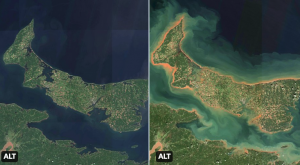 Figure 2: Canadian Space Agency satellite images taken on August 21, 2022 (left) and September 25, 2022 (right). Extensive coastal erosion of Prince Edward Island was caused by historic storm surge and wave activity associated with Hurricane Fiona.
Figure 2: Canadian Space Agency satellite images taken on August 21, 2022 (left) and September 25, 2022 (right). Extensive coastal erosion of Prince Edward Island was caused by historic storm surge and wave activity associated with Hurricane Fiona.
Climate scientists are not immune to climate anxiety. Many within our community have felt compelled to speak out publicly regarding the causes, consequences, and seriousness of global warming. Others have signed petitions, penned letters, written books and commented on social media sites. However, few have actively sought election to government office. This is unfortunate as I continue to believe that political will remains the greatest barrier to advancing climate policy including the decarbonization of global energy systems. But instead of helping to generate that political will, a large cohort of the climate science community, in an attempt to deal with their own climate grief, has heightened rather than alleviated climate anxiety in civil society.
Through this article, I hope to encourage that community to reflect upon the privilege and agency they have to refocus and mobilize their efforts towards advancing climate solutions within society, and to appeal to their sense of civic duty to inspire more to seek elected office. In particular, I argue that:
- Inaccurate scientific messaging associated with the 2018 IPCC Global Warming of 1.5°C report is feeding climate anxiety, and this is leading to despair in youth.
- There are more effective ways for scientists, armed with privilege and agency, to advocate for climate policy than fear-based messaging and civil disobedience.
As Albert Einstein famously noted: “Those who have the privilege to know have the duty to act, and in that action are the seeds of new knowledge.” After reading the rest of this blog, I hope you agree that this quote could be expanded with an additional sentence. “And as the new knowledge grows, the solutions to global warming are revealed.”
Scientific messaging is feeding climate anxiety
The 2018 IPCC Special Report outlining greenhouse gas emission pathways to limit warming to 1.5°C above preindustrial levels (IPCC, 2018) almost certainly contributed to an escalation of overall climate anxiety in recent years. The Special Report was a response to an invitation from signatories to the UNFCC as part of the Paris Agreement. The 2015 Paris Agreement, joined by 193 member states, has the specific goal of:
Holding the increase in the global average temperature to well below 2°C above pre-industrial levels and pursuing efforts to limit the temperature increase to 1.5°C above pre-industrial levels, recognizing that this would significantly reduce the risks and impacts of climate change (UNFCC 2015).
The aspirational 1.5°C target was added in response to lobbying by small island states (and their allies).
While the scientific community responded by outlining pathways to mitigate warming to 1.5°C in (IPCC, 2018), the subtleties embedded within the report seem to have been lost in its dissemination to the public. It is well known that the world has already warmed by 1.2°C since preindustrial times, and if we immediately eliminated all fossil fuel combustion worldwide, we would warm by an additional 0.5°C (IPCC 2021; see Figure 2) as the direct and indirect cooling global effects of aerosols (also associated with fossil fuel combustion) dissipate through gravitational settling and precipitation scavenging. The Earth would warm further as we equilibrate to the present 508 PPM CO2e (NOAA 2022) greenhouse gas loading in the atmosphere, and that is not counting the permafrost carbon feedback which could add another 0.1° to 0.2°C this century to committed warming (Macdougall et al, 2013).
In other words, meeting the 1.5°C target requires an immediate global scale up of negative emissions using technologies that have yet to be developed. Given socioeconomic inertia in our built environment (Matthews and Weaver, 2010), the scale of negative emissions required, and the preponderance of more urgent political priorities (i.e. healthcare, housing, inflation, the economy, the war in Ukraine and so forth), it is not possible for the world to meet the 1.5°C target.
Figure 3: Observed global warming (2010-2019 relative to 1850-1900) and the contribution to this net warming by observed changes to natural and anthropogenic radiative forcing. Reproduced from IPCC (2021).
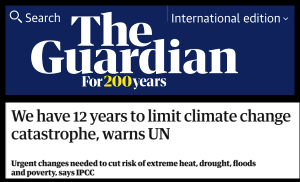 Climate anxiety is also fueled by media messaging related to the perception of a looming climate ‘crisis’ (Crandon et al., 2022). Take the anxiety effect of popular messaging related to the aspirational goal of remaining below a 1.5°C global warming threshold (IPCC, 2018). “We have only 12 years left to limit climate change catastrophe, warns UN” was the headline of a story published in the Guardian on October 8, 2018; “Only 11 years left to prevent irreversible damage from climate change, speakers warn during general assembly high-level meeting” was the headline of a press release issued by the United Nations on March 28, 2019 during its 73rd session (UN, 2019); “Climate change: 12 years to save the planet? Make that 18 months” was the headline of a BBC News story on July 24, 2019 (BBC, 2019).
Climate anxiety is also fueled by media messaging related to the perception of a looming climate ‘crisis’ (Crandon et al., 2022). Take the anxiety effect of popular messaging related to the aspirational goal of remaining below a 1.5°C global warming threshold (IPCC, 2018). “We have only 12 years left to limit climate change catastrophe, warns UN” was the headline of a story published in the Guardian on October 8, 2018; “Only 11 years left to prevent irreversible damage from climate change, speakers warn during general assembly high-level meeting” was the headline of a press release issued by the United Nations on March 28, 2019 during its 73rd session (UN, 2019); “Climate change: 12 years to save the planet? Make that 18 months” was the headline of a BBC News story on July 24, 2019 (BBC, 2019).
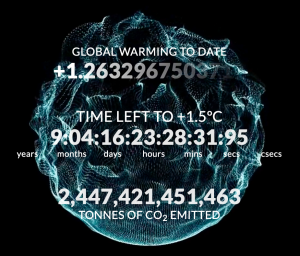 To amplify the urgency of further climate action, “Climate Clocks” were developed that purported to count down days until it was too late to avoid the worst impacts of global warming (see here and here). It is unclear how watching a countdown to catastrophe would do anything other than increase climate anxiety and instill a sense of hopelessness and despair. Political rhetoric from those with large followings, such as when Rep. Alexandria Ocasio-Cortez proclaimed “The world is going to end in 12 years if we don’t address climate change” (USA Today, 2019), also contributes to increasing climate anxiety.
To amplify the urgency of further climate action, “Climate Clocks” were developed that purported to count down days until it was too late to avoid the worst impacts of global warming (see here and here). It is unclear how watching a countdown to catastrophe would do anything other than increase climate anxiety and instill a sense of hopelessness and despair. Political rhetoric from those with large followings, such as when Rep. Alexandria Ocasio-Cortez proclaimed “The world is going to end in 12 years if we don’t address climate change” (USA Today, 2019), also contributes to increasing climate anxiety.
![]() Inherent in the 12 years left narrative, and the IPCC 1.5°C report is the implied notion that there is something magical about the number 1.5°C. Of course, there is no scientific rationale to justify an acceptable warming threshold of 1.5°C instead of 1.3°C or 1.672°C. Any defined level of ‘acceptable’ warming obviously involves an assessment of societal values and those will clearly be different depending on where you live in the world.
Inherent in the 12 years left narrative, and the IPCC 1.5°C report is the implied notion that there is something magical about the number 1.5°C. Of course, there is no scientific rationale to justify an acceptable warming threshold of 1.5°C instead of 1.3°C or 1.672°C. Any defined level of ‘acceptable’ warming obviously involves an assessment of societal values and those will clearly be different depending on where you live in the world.
In fact, even the 2°C threshold for acceptable warming originally only entered the public arena shortly after the IPCC released its Second Assessment Report and prior to the establishment of the Kyoto Protocol. In 1996, the Council of the European Union concluded:
The Council recognizes that, according to the IPCC S.A.R., stabilization of atmospheric concentrations of CO2 at twice the pre-industrial level, i.e. 550 ppm, will eventually require global emissions to be less than 50% of current levels of emissions; such a concentration level is likely to lead to an increase of the global average temperature of around 2°C above the pre-industrial level.
And:
Given the serious risk of such an increase and particularly the very high rate of change, the Council believes that global average temperatures should not exceed 2 degrees above pre-industrial level and that therefore concentration levels lower than 550 ppm CO2 [carbon dioxide] should guide global limitation and reduction efforts. This means that the concentrations of all greenhouse gases should also be stabilized. This is likely to require a reduction of emissions of greenhouse gases other than CO2 in particular CH4 [methane] and NO2 [sic; nitrous oxide].
Ironically, it was inconsistent on the one hand, for the EU Council to advocate for carbon dioxide to be stabilized at or below 550 ppm with emissions eventually dropping to less than 50% of 1996 levels, while on the other hand, arguing for the 2°C threshold not to be exceeded.
While ambitious goal-setting can in theory be an effective motivator of action (Locke and Latham, 2002), in practice, alarmist media reframing (Ereaut and Segnit, 2006) of failure to remain below the 1.5°C goal into a scenario of impending doom has become quintessential fuel for personal climate anxiety. Taken in the collective across society, climate anxiety driven by personal concern and amplified by poorly calibrated media messaging is quickly emerging as a dominant factor in the collective zeitgeist of the Anthropocene (e.g. Crutzen 2006, Hickman et al 2021, Wray 2022).
Given that most of today’s decision-makers will not be around to be held accountable for their action, or lack thereof, towards meeting various targets set well into the future, a more appropriate framing and scientifically justifiable statement is for society to collectively do what we can to avoid as much warming as possible. Every tenth of a degree warming avoided reduces our collective climate risk and, by corollary, our overall collective climate anxiety.
But this still doesn’t address how individual climate anxiety can be reduced.
A far more constructive approach would be for the scientific community to turn our collective attention to climate solutions, not climate fear mongering or climate alarmism. Take the recent viral Tik Tok video showing Nasa Scientist Dr. Peter Kalmus prior to getting arrested after chaining himself to a JP Morgan Chase building in Los Angeles. The emotion in Dr. Kalmus’ voice indicates that he is likely dealing with his own climate anxiety, but I question whether or not the message in his viral video did anything more than increase the level of anxiety within children and youth worldwide:
“So, I am here because scientists are not being listened to. I am willing to take a risk for this gorgeous planet. That sucks, and we’ve been trying to warn you guys for so many decades now we are heading towards a catastrophe. And we are being ignored, the scientists of this world are being ignored, and it’s got to stop. We are going to lose everything, and we are not joking. We are not lying; we are not exaggerating. This is so bad everyone that we are willing to take this risk and more and more scientists, and more and more people are going to be joining us. This is for all the kids of the world — all of the young people, all of the future people. This is so much bigger than any of us. It’s time for all of us to stand up and take risks and make sacrifices for this beautiful planet that gives us life.”
At no point were any solutions posed, any positive actions suggested, or any personal climate risk reduction advocated for. The scientists involved likely believed that they were raising public awareness of the seriousness of global warming. Yet I argue that these same scientists abdicated their position of power and privilege by inadvertently pretending to be on the same footing as those most affected by climate change. In doing do, the scientists did little more than stoke the fires of climate anxiety when they had agency to facilitate constructive change both within their public engagements, as well as their own personal choices.
It’s also long been known that fear based messaging does not work in terms of motivating personal climate action (e.g., O’Neill and Cole (2009) , Stern (2012), Climate Tracker (2017). In fact, many simply disassociate themselves from the issue. Others, of course, take the fear to heart and it feeds their underlying climate anxiety.
Articles like McKay et al., 2022, with provocative, if not highly speculative, titles may attract media attention in the lead up to an annual UNFCCC COP event. But they are often framed as opinion or expert assessment and so are often highly controversial and not representative of broad scientific consensus. Extremely low probability, perhaps even impossible, but certainly poorly understood tipping point scenarios often end up being misinterpreted as likely and imminent climate events. The nuances of scientific uncertainty, the differences between hypothesis posing vs hypothesis testing, and the proverbial “implications of this work” throw away statements, wherein scientists take creative license with speculative possibilities, are all lost on the lay reader as the study goes viral across social media.
More recently, some activists have even called on the scientific community to engage in more civil disobedience (e.g., Capstick et al., 2022, Earth.org, 2022) arguing that it is effective and leads to change. Once more, I am not sure how activist scientists with agency help advance the necessary solutions and believe that the time for such activism has long passed. Governments around the world have committed to climate action but are struggling to advance the various solutions required for the low carbon economies of tomorrow. They need help, ideas, solutions and ongoing support and the scientific community is ideally positioned to assist in this regard.
In fact, many look to the climate science community for leadership on greenhouse gas mitigation and do so with dismay when they see these same scientists jetting off to various conferences, UNFCCC COP/IPCC meetings and workshops at exotic locations around the world. How many thousands of people attended the 26th Conference of Parties meeting of the United Nations Framework Convention on Climate Change in Glasgow in 2021? How many attended the 27th meeting in Sharm el-Sheikh in 2022? Was their presence really necessary? Climate scientists, with their privilege and agency, not only have a responsibility to assist identifying and implementing climate solutions; they also need to model the climate leadership they are calling on others to follow. Failing to do so sends the wrong message, a message that undermines the prevailing narrative that we are in a “climate emergency”.
More effective ways for scientists to advocate for climate policy
The climate science community operates from a position of privilege in the public discourse of climate change science, its impacts and solutions. Whether it be by participating in the writing of IPCC reports or our own research, climate scientists have defined the scale of the global warming challenge, outlined pathways to decarbonization of our energy systems, and documented a suite of future impacts, many of which would be very detrimental to future societies. We’ve also quantified the climate risk to our natural and built environment. Armed with this knowledge, climate scientists, more than most, are well-informed and so have agency in the advancement of climate solutions. But when climate scientists participate in civil disobedience or do little more than criticize others for inaction, they abdicate that position of privilege and agency by pretending to be on the same footing as others in society who are not as well informed on the nuances of climate change. As such, rather than alleviating their own, and broader society’s, climate anxiety, they fuel it further by inadvertently ratcheting up the rhetoric with nothing to offer in terms of overall solutions or risk reduction. I firmly believe that the climate science community has a duty and responsibility to become more actively engaged in the delivery of climate solutions in whatever form they feel most comfortable work with (i.e., nature-based, technological, socioeconomic or policy solutions).
At the same time, the scientific community must be reminded that they are but one stakeholder in the global warming debate. Whether or not society wishes to respond to the challenge of global warming really boils down to one question. Do we the present generation owe anything to future generations in terms of the quality of the environment we leave behind? Yes or No? Science cannot answer this question; but it can help articulate the expected consequences of action or inaction. Science can also inform decision makers by pointing out that if the answer to the above question is yes, dramatic GHG reductions (both through the decarbonization of energy systems and the introduction of negative emission technology) must commence now. Waiting until the future to start reducing emissions means waiting until it is too late.
While the answer to the above question is fundamentally personal, most almost certainly would respond yes, particularly those who have children. Yet some would disagree. For example, “Some evangelicals argue that global warming is of little concern when the end times are approaching. Indeed, it could even be proof of it” (Gander, 2019); Fatalists may believe that what will occur in the future is inevitable, perhaps even a manifestation of God’s will, and so believe that an individual’s actions or choices will have no effect on the direction we are heading. Libertarians may focus on the importance of individual freedoms, express concern about government overreach and regulation and may advocate for a laissez-faire approach to climate policy. There might be some who might answer yes to question, but their deep suspicion of environmentalists may make them question the urgency of dealing with global warming. Then of course there are those who will have been swept up in the various conspiracy theories so prevalent on the internet these days. Fortunately, the Pew survey cited above (Bell et al., 2021) allows us to estimate that it is only about 20% of the population who will likely object to the advancement of climate policy. And so, I am of the firm belief that engaging with this audience is counter-productive and a waste of a climate scientist’s time.
Instead of trying to persuade the unpersuadable, participating in civil disobedience or publicly demanding government take unspecified actions it would be far more productive if the scientific community, turned their attention to the development and advancement of climate solutions. This can be accomplished in any one of a number of ways. For example:
- Supporting progressive government policy vocally and publicly once it has been introduced;
- Running for office;
- Advocating for constructive solutions in recognition that we have agency and we occupy a position of privilege in society.
Given the emergence of social media in this post-truth age we are seeing more and more populist policies globally wherein decisions are made first, and then evidence (real or imagined) is sought after the fact to support an ideological agenda — this is what I call decision-based evidence-making, the antithesis to the scientific method. Scientists are driven by the quest to understand the world around us. We are driven by evidence. We identify problems and then take steps to solve these problems using reproducible techniques. Central to who we are as scientists is the notion of evidence-based decision-making. We understand this notion and react strongly to decision-based evidence-making, the antithesis to the scientific method. I truly believe our community has an inherent responsibility to exhibit the necessary leadership (especially through our own behaviour) to ensure that we play a constructive role in identifying solutions to the environemental problem that we have spent so many decades studying.
Finally, a co-benefit our community will warmly welcome in the move towards a climate-solutions focus, is the amelioration of our own climate anxiety (not to mention broader societal climate anxiety). I say this from personal experience, having worked in the field since the 1980s. Climate scientists, like others in the general public, often also struggle with the notion of climate anxiety and grief. But unlike others in the general public, our community holds agency and a position of privilege in the global warming debate. Rather than denying this agency and privilege I am hopeful that as a community we will collectively rise to the myriad opportunities global warming has afforded us for constructive public engagement and the betterment of society.
In the weeks ahead, I hope to expand upon these initial ideas by offering more concrete examples of engagement and responding to any feedback coming my way from this post.
Leave A Comment
Latest Posts
Recent Comments
- Adeola on The Paris Agreement is in trouble: UNFCCC needs to ratchet up their climate efforts
- rory murphy on The Paris Agreement is in trouble: UNFCCC needs to ratchet up their climate efforts
- Andrew Weaver on How can BC’s environmental organizations be more effective?
- Andrew Weaver on How can BC’s environmental organizations be more effective?
- Vince Fiorito on How can BC’s environmental organizations be more effective?


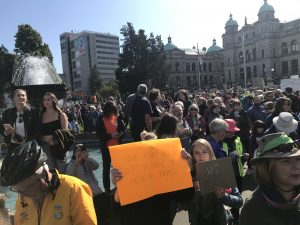



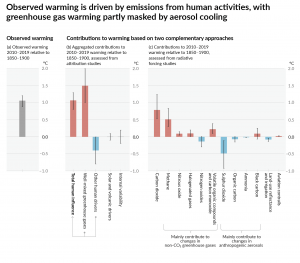



8 Comments
On Shaw’s comment: working with the fossil fuel industry has failed. They spend billions on greenwashing and buying off governments to maintain their power. Who isn’t sick and tired of this delusional view of “ working with them”.
On Milloy’s comments:: It’s not the burden and responsibility of scientists to take on THE ADDED BURDEN of creating policy and laws beyond ‘outlaying pathways’ . NOT THEIR JOB. This has been the failure of public institutions and the idiots elected , like the corrupt morons within the GOP. DECADES OF IT.
Thank you for your comment. I understand your apparent frustration. While it is true that it is not the job of a lab-bench scientist to create policy, it doesn’t preclude them from identifying solutions.
It is easy to mobilize folk ‘against’ something; wouldn’t it be a change if people mobilized ‘for’ something as well.
Have spent the best part of a decade reading a great many articles/reports on Earth’s ever-changing climate, and although I do appreciate Andrew Weaver as an individual, my conclusions from all that I have learned are rather directly opposed to his positions. The most succinct summary, perhaps, is that of Piers Corbyn:
“We are plunging now into a deep mini-ice age and there is no way out. The fact is the sun rules the sea temperature, and the sea temperature rules the climate. Under Grand Solar Minimum conditions, the jet stream will be wilder, resulting in wider and more sudden temperature changes; late springs, lousy summers, short autumns, and heavier winter snows . . . with more and more crop failures.”
The mini-ice age … identified by a number of climate scientists as being rooted in 2013 had a slow start, but heat loss is now accelerating. Planet Earth has now had eight consecutive years of global cooling, (NOAA), intensifying in 2022 from a loss of 0.11C per decade to a heat loss of 0.19C per decade.
Hello Ken, I spent some time wondering whether or not I would approve this comment for posting. I welcome discussions about policy, the content of my post, etc. But I do not want to provide a forum for promoting inaccurate scientific assertions. Please note, moving forward, posts like this will not be approved. It is simply false to state “we are plunging now into a deep mini-ice age and there is no way out.” It is simply false to say: “The mini-ice age … identified by a number of climate scientists as being rooted in 2013 had a slow start, but heat loss is now accelerating. Planet Earth has now had eight consecutive years of global cooling, (NOAA), intensifying in 2022 from a loss of 0.11C per decade to a heat loss of 0.19C per decade.”
Do you feel more effective now/
I am enjoying being back at the University of Victoria.
It was some 25 years ago that I studied Atmospheric Science under Dr. Weaver at UVic. He’s absolutely right. While he taught about the dynamics of the ocean-atmosphere system, there was no anxiety about it in our class. We were armed with fundamental knowledge about highly complex systems and there was no bitterness, no judgement, and no sense of pending doom. Being part of what was then called the School of Earth and Ocean Sciences, we all had an appreciation for the dramatic changes that the planet and climate had historically seen over timescales ranging from tens of thousands of years to hundreds of millions of years, and there was also an appreciation for the fact that the changes we were beginning to see were occurring over a much shorter timescale than anything that anyone had seen before. At the same time, there was a humility about all of it, as we all knew that the processes at work were governed by so many variables that we could only begin to broadly understand how the Earth-ocean-atmosphere system would respond. In all of us, it instilled a sense of respect for the planet and its ability to adapt to just about whatever was thrown at it — and we always remembered that, in the end, the entire existence of modern society would likely be reduced to a layer of gravel in the geologic record. We never worried about the “end of the world”, but we did learn that we should not expect a static climate as a long-term condition. Drought was already changing landscapes in the southwest U.S. and we knew that adaptation would be required. There was never a sense hopelessness though — just problems to be solved.
As Dr. Weaver points out here, the climate horse has already left the barn to some degree, and instilling panic and peddling fear-mongering is not a viable response. I’ve read countless articles written by non-scientists who literally appear to believe the world will actually come to an “end” in their lifetime, complete with total destruction of the biosphere. Fire and brimstone kind of stuff. Not figuratively — literally. It terrifies me that people believe that the end of days is inevitable and irreversible, and that we are simply the walking dead in the meantime. There is no hope in that message, and it is woefully inaccurate. Our mastery of energy and materials over the last ~175 years has enabled adaptation and innovation on a scale unmatched by any species that has ever existed before on the Earth. Our technology now verges on wizardry and our ability to identify issues like climate change is built on the back of the very industrial development that many would seek to demonize today. The issues we have identified are both multi-faceted and solvable, but they cannot be solved by irrational fear and misguided “plans” that have no basis in practical reality.
As one example, I’ve read positions from groups who actually oppose carbon capture and sequestration on the basis that those technologies would “enable” the proliferation of the hydrocarbon industry. Nothing could be further from reality. There are 8 billion people on the Earth today and mitigation of our impacts is of utmost importance. That mitigation will be based on both awareness and technology — and the continued mastery of energy and materials in order to be successful. There is nothing inherently wrong with hydrocarbons, but the emissions need to be managed. Policymakers need to be educated in the practical realities of potential responses to the challenges we face today or we risk a far greater peril rooted in ignorance that will paralyze our ability to adapt and respond. All solutions will come with a cost and if that cost is unpalatable economically, those solutions will be doomed to fail the very people and systems that we would seek to protect.
We cannot shrink our way out of climate change, nor can we expect infinite exponential “growth” of the current economy without significant changes to how our finite resources are managed and developed. Meanwhile, we cannot expect to impose our expensive energy solutions on the developing world where meeting basic daily needs is far more front of mind than a somewhat abstract future concept like climate change. We must demand better of our politicians and policymakers, holding them to a higher standard of understanding in terms of the issues we face and what kinds of actions would constitute logical responses. At the same time, I believe institutions need to tone down the alarmist rhetoric as it detracts from the credibility of the movement as a whole by polarizing realist and activist viewpoints. At this juncture, my biggest concern is that we are wasting significant intellectual and real capital on overanalyzing an issue that doesn’t require, or benefit from, hyperbole. We need to shift the discussion from one of blame, guilt, and impending doom to one of solutions, cooperation, and hope.
I think that Dr. Weaver is right when he suggests that politicians who govern based on election cycles and a desire to maintain office are failing their constituents term, after term, after term. Most politicians pander to “popular” views, with some guilty of one-upping each other in terms of virtue signalling like it’s some kind of sport to be won. The real solution requires active government engagement with the industries that will ultimately come up with the solutions to the emissions challenges that we face. History has shown, time and time again, that governments are horrible allocators of capital and resources, and I believe that the engagement of industry experts is critical to making real, achievable, changes over time. Perhaps that it a place to start — where politicians and international bodies like the UN invite industry leaders to work with them to find solutions, as opposed to drafting plans in a vacuum and spitting them forth from their ivory towers.
I have spent the last 25 years as a geologist, a financial analyst, and a communicator who bridges gaps between disciplines. I firmly believe that our ‘climate salvation’ will be found in cooperation and collaboration between government and industry — not in demonization and polarization. As a motivator, a carrot has always worked better than a stick, so let’s start by actively engaging with and listening to the industries that we need to change instead of trying to beat them into submission with a fearful government and disillusioned public. How’s that for a start?
Thanks to Prof. Weaver for his service in science, academia and representative government. Those are valuable venues to help make climate solutions happen.
I must disagree that “Governments around the world have committed to climate action but are struggling to advance the various solutions, and “Climate scientists have… outlined pathways to decarbonization of our energy systems,”. Governments have in Greta’s words, “blah, blah, blah”. It’s easy for them to promote renewable energy sources and fantasy CCS as long as solutions don’t draw down fossil fuels.
Climate scientists must do more than outline pathways. They must help draft specific ff draw down programs and legislation to carry them out. These will serve as essential general strike/boycott demands.
Influential climate scientists must publicly support those who will nonviolently not work or buy nonessentials. Big donors control governments with money. Drawing down GDP will cost non-fossil fuel donors big money. They will tell politicians to pass the laws to meet climate, biome restoration and human rights demands.
We must do everything all at once* to quickly cut carbon emissions to keep climate livable. And quickly restore the biosphere to try to keep most living things alive. * @BillNye
Hope is waiting for someone else to do it. The COPs have failed us. People, give up hope and start taking effective actions today. Prepare to strike and boycott.
Andrew Milroy
B.S., M.S., J.D.